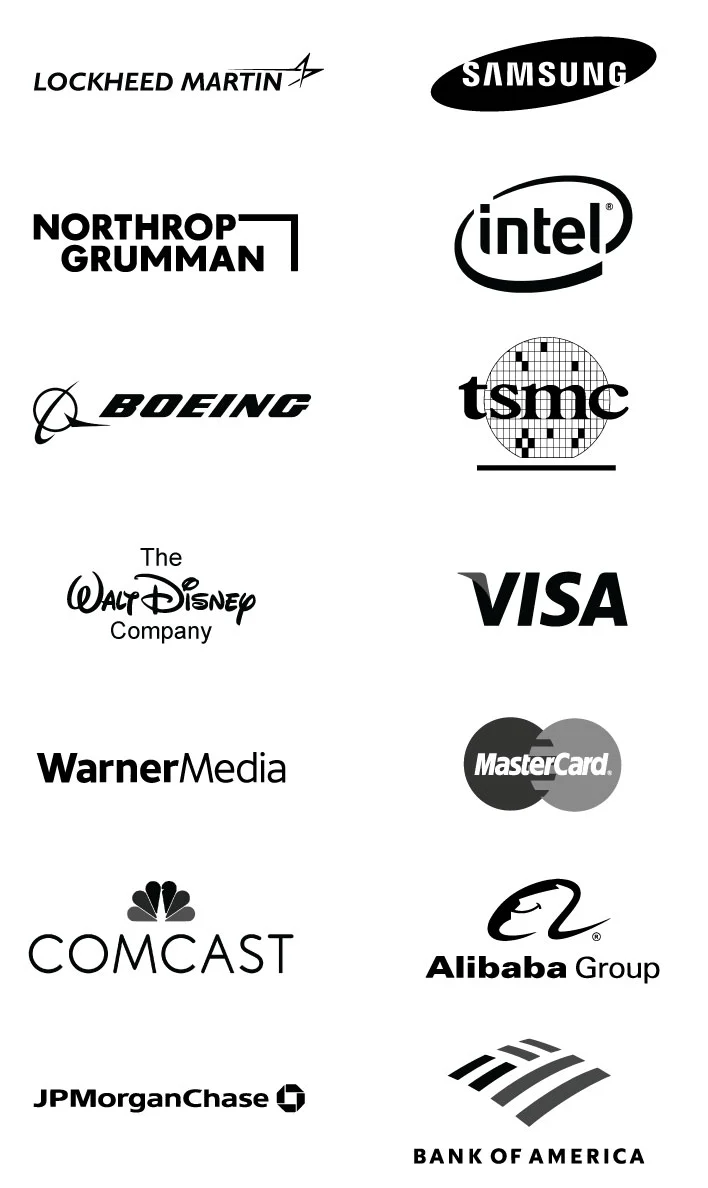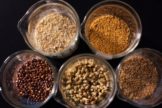
Feed Enzymes Market By Type(Phytase, Protease, Carbohydrase), By Livestock (Ruminants, Swine, Poultry, Aquatic animals, Others (equine and pets)), By form (Liquid, Dry), By Region And Companies - Industry Segment Outlook, Market Assessment, Competition Scenario, Trends, And Forecast 2023-2032
-
5342
-
May 2023
-
150
-
-
This report was compiled by Shreyas Rokade Shreyas Rokade is a seasoned Research Analyst with CMFE, bringing extensive expertise in market research and consulting, with a strong background in Chemical Engineering. Correspondence Team Lead-CMFE Linkedin | Detailed Market research Methodology Our methodology involves a mix of primary research, including interviews with leading mental health experts, and secondary research from reputable medical journals and databases. View Detailed Methodology Page
-
Quick Navigation
Report Overview
Feed Enzymes Market size is expected to be worth around USD 2.5 Bn by 2032 from USD 1.4 Bn in 2022, growing at a CAGR of 6.4% during the forecast period from 2023 to 2032.
The feed enzymes market is an essential component of the livestock industry, garnering extensive acceptance and popularity due to its potential to enhance animal health and growth. Feed enzymes refer to the enzymes that are added to animal feed to improve the digestion and absorption of nutrients, thereby substantially augmenting the overall dietary efficiency of the animal. Notable is the exponential growth rate of the global feed enzymes market, which is primarily driven by the rising demand for high-quality animal proteins and the need for sustainable agricultural practices.
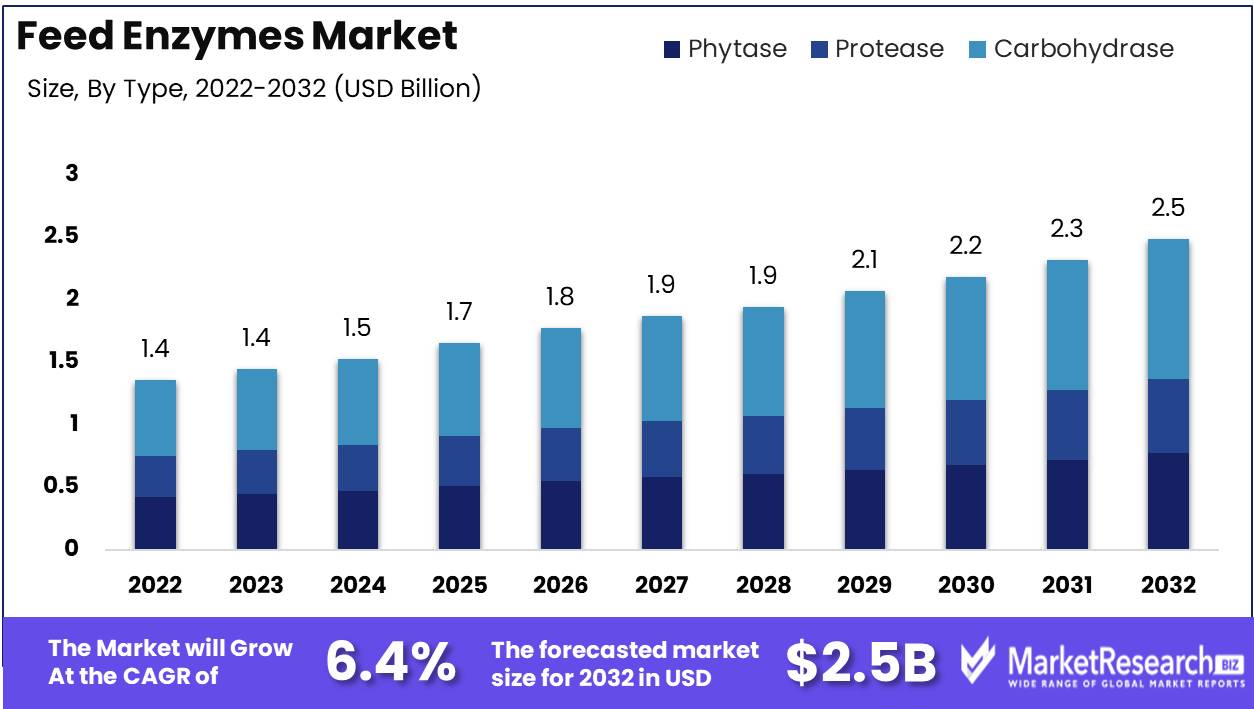
Animal nutrition cannot exist without feed enzymes, which catalyze the decomposition of complex feed components and enhance the animal's ability to extract energy and nutrients from its food. The incorporation of feed enzymes has been demonstrated to be advantageous in a variety of circumstances, such as enhancing feed conversion rates, reducing the environmental impact of livestock production, and increasing animal health and welfare.
There is no doubt regarding the significance of feed enzymes in the livestock industry. The primary benefit of incorporating feed enzymes rests in the improved efficacy of animal nutrition, which can result in increased productivity, decreased costs, and enhanced environmental sustainability. In addition, feed enzymes can improve the palatability of the feed, thereby stimulating the animal's appetite and encouraging consistent consumption. Given their potential to reduce the environmental impact of livestock production, the rising demand for sustainable agricultural practices has further increased the significance of feed enzymes.
The application of feed enzymes has evolved over time, with significant advances in enzyme production and formulation methods. Encapsulated enzymes that protect enzymes from gastric acid and convey them directly to the target site in the intestines are an example of an innovative delivery format. In addition, the use of genetically modified enzymes and the creation of multi-enzyme combinations have expanded the spectrum of feed substrates that can be targeted.
Increasing demand for high-quality animal proteins, which has been predominantly driven by population growth, rising incomes, and altering consumer preferences, has contributed to the expansion of the feed enzymes market. The poultry and livestock industries have been the most significant consumers of feed enzymes, as the feed enzymes market has expanded rapidly. Additionally, the use of feed enzymes has expanded to include livestock, aquaculture, and companion animals. The growing trend towards sustainable and organic agricultural practices is also anticipated to increase the demand for feed enzymes.
Driving factors
Rising Demand for Animal Protein
Because of factors such as rising population and shifting eating patterns, there is a growing need for protein derived from animals all throughout the world. Because of this, there has been a rise in the demand for feed enzymes, which enhance the nutritional value and digestibility of animal feed, ultimately leading to improved animal health and performance.
Production of Feed That Is Efficient and Affordable
Farmers and producers are seeking ways to improve productivity and lower expenses as a result of the rising cost of raw materials and inputs. Feed enzymes can be helpful in increasing the amount of feed that is converted into usable energy while simultaneously cutting down on the amount of waste produced, hence lowering costs for both the producers and the consumers.
Regulations issued by the government
As more people become concerned about the long-term health of the environment and the treatment of animals, governments all over the world are enacting new regulations and guidelines for agricultural production. In order to maintain their position as market leaders, businesses operating in the feed enzymes market are required to comply with these regulations.
Concerning the Health and Well-Being of Livestock
In order to limit the usage of antibiotics and other treatments, producers are seeking ways to improve the health of their animals. Feed enzymes can be beneficial in that they can improve the health of the animals' digestive tracts and lower the risk of illness, leading to increased production and profitability.
Restraining Factors
Increased Governmental Regulations and Approvals
Government regulations and approvals that must be obtained prior to the use of feed enzymes constitute one of the market's most significant obstacles at present. Various government agencies regulate the use of feed enzymes in livestock production and require extensive testing and approval prior to their use in animal feed.
This has made it difficult for manufacturers of feed enzymes to introduce new products to the market. The lengthy and expensive approval procedure has prevented many companies, particularly smaller competitors, from entering the market.
High Cost of Feed Enzymes
The price of feed enzymes is also a significant factor inhibiting market expansion. Although the use of feed enzymes can be advantageous for producers, the high price of these enzymes makes them not always cost-effective.
Many producers cannot rationalize the cost of feed enzymes because they are prohibitively expensive. This has limited the utilization of feed enzymes in a number of regions, further impeding market expansion.
Type Analysis
The Carbohydrase segment dominates the Feed Enzymes market
The feed enzymes market is segmented into enzyme categories such as carbohydrase, protease, and others. Due to its high demand in animal feed, the carbohydrate segment dominates the market among these products. Carbohydrates are broken down by carbohydrase enzymes into simple sugars that are readily assimilated by animals. This segment contains various enzymes, including amylases, cellulases, and xylanases.
The rising demand for animal protein and advances in animal feed technology has contributed to the expansion of the carbohydrates market. In addition, the use of feed enzymes has numerous advantages, including improved digestion, increased feed efficiency, and improved growth performance in animals.
Emerging societies' economic growth has played a significant role in promoting the adoption of feed enzymes. Due to a rise in disposable income and a shift in dietary preferences, the demand for animal protein in these nations is growing. Increasing urbanization and industrialization have also contributed to the expansion of the animal fodder industry.
Livestock Analysis
The swine segment dominates the feed enzymes market.
Due to the high demand for pork and the need for improved swine feed technology, the swine segment dominates the feed enzymes market. Swine feed enzymes are used to increase nutrient utilization, reduce feed costs, and boost swine growth. This segment contains various enzymes, including carbohydrates, proteases, and phytases.
The advancements in swine feed technology and the rising demand for pork have contributed to the expansion of the swine segment. In addition, the use of feed enzymes in pig feed has numerous advantages, including increased feed efficacy, enhanced growth performance, and decreased environmental impact.
The economic growth of emergent nations has had a significant impact on the growth of the pig segment of the feed enzymes market. Due to rising disposable income and shifting dietary preferences, the demand for pork in these nations is on the rise. Increasing industrialization and urbanization have also contributed to the expansion of the pig industry.
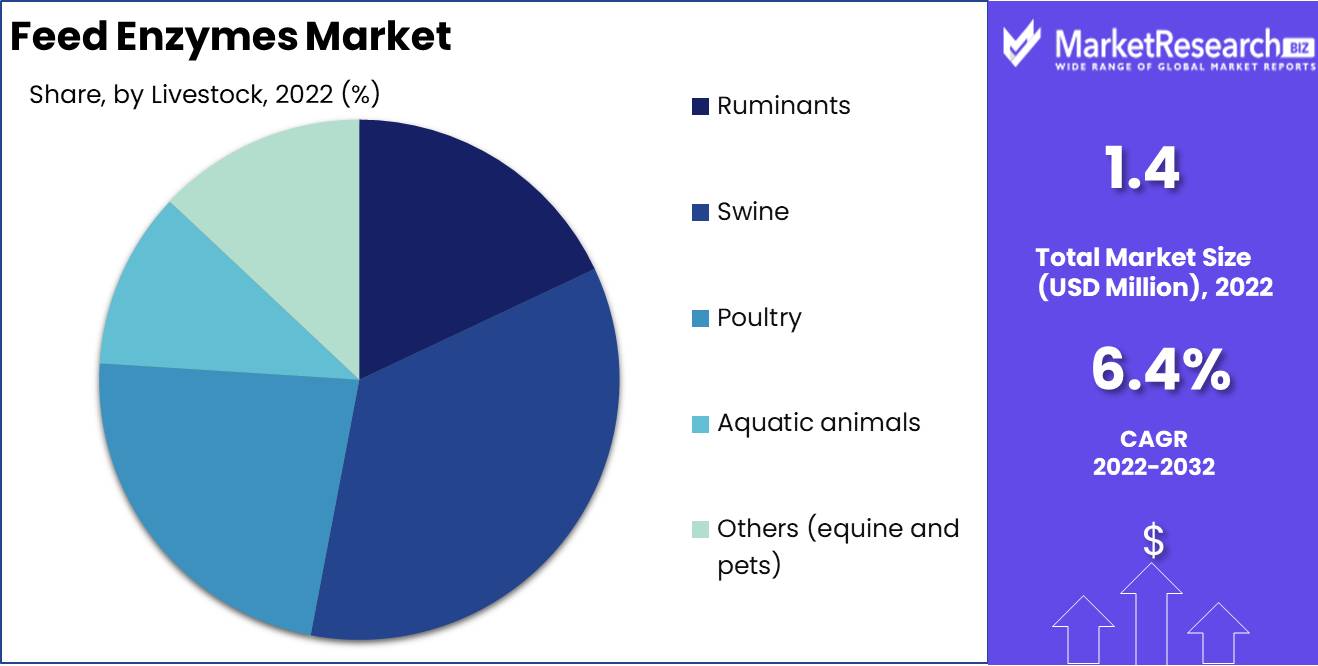
Key Market Segments
By Type
- Phytase
- Protease
- Carbohydrase
By Livestock
- Ruminants
- Swine
- Poultry
- Aquatic animals
- Others (equine and pets)
By form
- Liquid
- Dry
Growth Opportunity
Adoption of Specialty Enzymes in the Animal Feed Industry Expanding
The animal feed industry is swiftly evolving, and the demand for high-quality animal feed is growing. In recent years, the use of specialized enzymes in the animal feed industry has increased significantly. The digestive health and performance of animals can be improved with the help of specialized enzymes. In addition, they help to reduce overall feed costs by increasing feed conversion efficiency. Enzymes such as phytases, proteases, and amylases are essential for enhancing the digestibility of animal feed constituents.
Increasing Understanding of Animal Nutrition and Health
Regarding the significance of animal nutrition and health, there is a growing awareness among feed manufacturers and animal proprietors. Consumers now demand high-quality animal feed that contains the essential nutrients for animals' optimal growth and development. Additionally, animal owners seek out feed products that can help to improve their animals' overall health and well-being. This has increased the demand for feed enzymes that help to improve the absorption and utilization of nutrients by animals.
Increasing Research and Development Spending on Innovative Feed Enzymes
The feed enzymes market is extremely competitive, with companies investing significantly in the research and development of new feed enzymes. These companies are developing new products that can satisfy the changing demands of consumers and help improve the overall efficacy of animal feed. Novozymes, one of the leading competitors in the feed enzymes market, has invested significantly in the research and development of enzymes that can help reduce the environmental impact of livestock production.
Increasing popularity of natural and organic feed additives
Among animal proprietors and feed manufacturers, there is a growing preference for natural and organic feed additives. Consumers now demand high-quality animal feed devoid of toxic chemicals and synthetic additives. This has increased the demand for organic and natural feed additives such as enzymes. These natural and organic feed additives are not only safe and beneficial for animals, but they also help to increase the overall efficiency of animal feed.
Market for Pet Food and Animal Supplements Is Expanding
In recent years, the pet food and animal supplement market has experienced significant expansion. Growing demand for high-quality pet food and animal supplements drives the market. Consumers are now seeking pet food and animal supplements that contain natural and organic ingredients, which can help improve the overall health and well-being of their pets. This has increased the demand for feed enzymes that can help improve the digestibility and nutrient utilization of pet food and animal supplements.
Latest Trends
Industrial opposition
The industry of feed enzymes is extremely competitive, with participants competing on a variety of factors, including product quality, pricing, and innovation. Competition in the industry is primarily propelled by the rising demand for animal nutrition and the rising awareness of the advantages of feed enzymes. Companies are investing significantly in research and development (R&D) to create new and innovative feed enzymes that enhance animal health and nutrition while reducing production costs.
Environmental considerations
Environmental concerns are driving market adjustments in feed enzymes. The use of feed enzymes has been linked to reduced greenhouse gas emissions, and a growing number of nations are enacting policies that encourage the use of feed enzymes in animal feed. The European Union, for instance, has set goals for reducing greenhouse gas emissions, and the use of feed enzymes is one of the measures being implemented to reach these goals. Companies that invest in the development of feed enzymes that reduce environmental impact will likely acquire a market advantage.
A growing understanding of animal nutrition
The growing awareness of animal nutrition is also driving changes in the feed enzymes market. The impact of animal nutrition on animal health, product quality, and the environment is becoming more apparent to consumers. This has increased the demand for feed enzymes that enhance animal health and nutrition while reducing the environmental impact of animal production. Companies that invest in the development of feed enzymes that satisfy these consumer needs are likely to achieve market success.
Regional Analysis
The expansion of the feed enzymes market in the Asia-Pacific region can be attributed to the rising demand for animal protein, particularly in China, India, and Japan, which have large populations and rising incomes. Utilizing feed enzymes improves animal health and performance, which in turn increases producers' production efficiency and profitability.
The increasing demand for animal protein in the region is a significant factor. As the Asia-Pacific region continues to experience economic growth and rising incomes, demand for livestock, dairy, and other animal-based products increases. This has resulted in a rise in livestock production, which has increased the demand for feed enzymes.
Increasing awareness about animal nutrition and health is another factor contributing to the growth of the feed enzyme market in the region. With a growing emphasis on sustainable agriculture and food security, there is a greater emphasis on boosting animal feed quality and enhancing animal health and performance. Feed enzymes are one method for achieving these objectives, as they enhance nutrient Utilization and metabolism in animals, thereby enhancing their health and productivity.
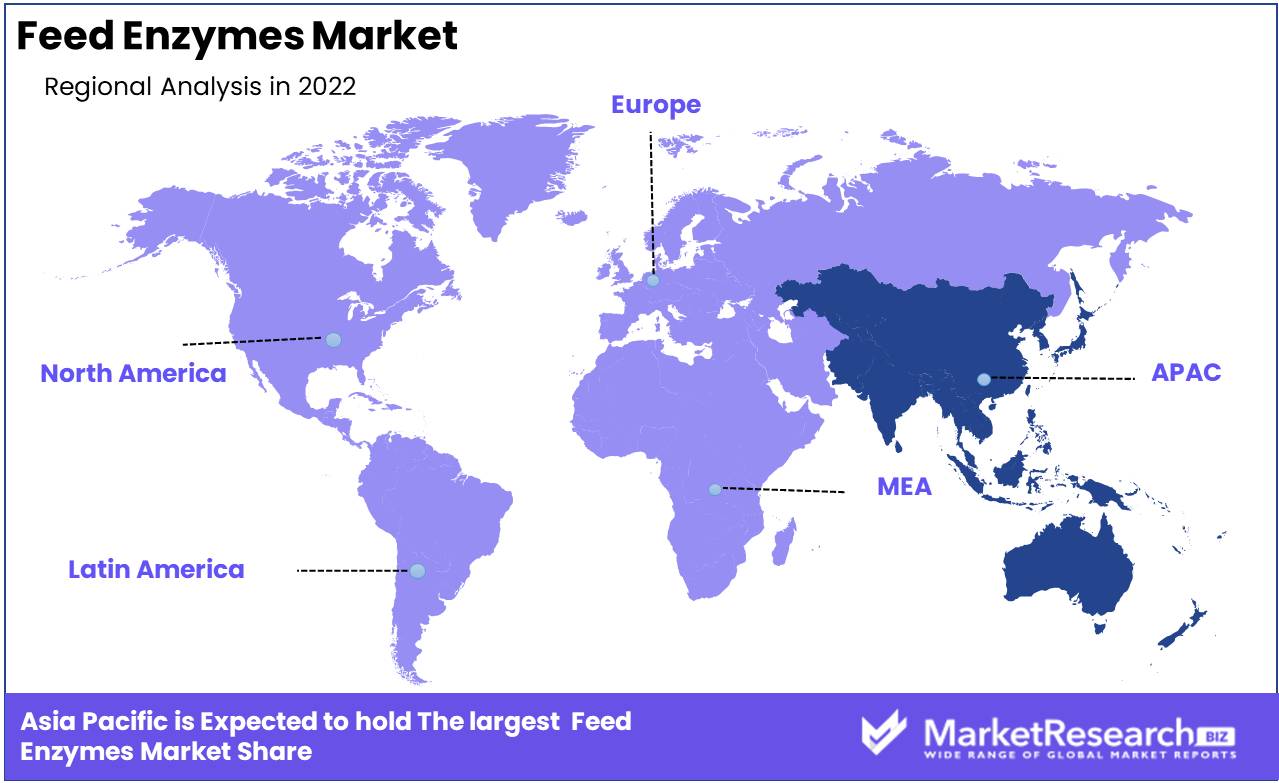
Key Regions and Countries
North America
- US
- Canada
- Mexico
Western Europe
- Germany
- France
- The UK
- Spain
- Italy
- Portugal
- Ireland
- Austria
- Switzerland
- Benelux
- Nordic
- Rest of Western Europe
Eastern Europe
- Russia
- Poland
- The Czech Republic
- Greece
- Rest of Eastern Europe
APAC
- China
- Japan
- South Korea
- India
- Australia & New Zealand
- Indonesia
- Malaysia
- Philippines
- Singapore
- Thailand
- Vietnam
- Rest of APAC
Latin America
- Brazil
- Colombia
- Chile
- Argentina
- Costa Rica
- Rest of Latin America
Middle East & Africa
- Algeria
- Egypt
- Israel
- Kuwait
- Nigeria
- Saudi Arabia
- South Africa
- Turkey
- United Arab Emirates
- Rest of MEA
Key Players Analysis
As a result of the rising need for animal protein, the feed enzymes market has developed into a highly lucrative industry. Feed enzymes are enzymes that are given to animal feed in order to promote the health of the animal's digestive tract, boost nutrient absorption, and improve feed efficiency.
There are a few main competitors in this market who are now dominating the industry thanks to the new product offerings, smart alliances, and aggressive marketing tactics that they have implemented. DSM, a Dutch multinational firm that produces a variety of vitamins, nutritional products, and enzymes, is one of the top competitors in this market. The product portfolio of the firm comprises a diverse selection of enzymes, including phytases, xylanases, proteases, and amylases, amongst others.
Novozymes, a Danish biotechnology firm that manufactures enzymes used in a number of applications including animal nutrition, is another significant participant in the feed enzymes market. The business provides cutting-edge feed enzyme products such as Avizyme, which improves nutrient digestibility and feed efficiency in swine and poultry.
Top Key Players in the Feed Enzymes Market
- BASF SE
- I. Du Pont De Nemours and Company
- Associated British Foods PLC
- Koninklijke DSM N.V.
- Adisseo France SAS
- Azelis Holdings SA
- Novus International, Inc.
- Novozymes
- Danisco A/S
- BioResource International, Inc.
Recent Development
- In 2023, Novus International acquired Agrivida, a biotechnology company, to develop new feed additives. Agrivida is a Brazilian company that develops and markets enzymes and other feed additives for the poultry, pork, and dairy industries.
- In 2022, DSM acquired the prominent Brazilian animal nutrition and technology company Prodap. Prodap is a privately held company that develops and markets animal feed additives, premixes, and other products.
- In 2022, Cargill extended its partnership with Innovafeed to offer aquafarmers innovative and nutrient-rich ingredients, including additives. Innovafeed is a French company that manufactures fish and shrimp feed made from insects.
- In 2021, BASF introduced a new poultry protease named ProAct 360. ProAct 360 is a feed enzyme that improves the protein digestibility of poultry feed. The enzyme is anticipated to assist poultry farmers in reducing feed costs and improving the performance of their birds.
Report Scope
Report Features Description Market Value (2022) USD 1.4 Bn Forecast Revenue (2032) USD 2.5 Bn CAGR (2023-2032) 6.4% Base Year for Estimation 2022 Historic Period 2016-2022 Forecast Period 2023-2032 Report Coverage Revenue Forecast, Market Dynamics, COVID-19 Impact, Competitive Landscape, Recent Developments Segments Covered By Type(Phytase, Protease, Carbohydrase), By Livestock (Ruminants, Swine, Poultry, Aquatic animals, Others (equine and pets)), By form (Liquid, Dry) Regional Analysis North America – The US, Canada, & Mexico; Western Europe – Germany, France, The UK, Spain, Italy, Portugal, Ireland, Austria, Switzerland, Benelux, Nordic, & Rest of Western Europe; Eastern Europe – Russia, Poland, The Czech Republic, Greece, & Rest of Eastern Europe; APAC – China, Japan, South Korea, India, Australia & New Zealand, Indonesia, Malaysia, Philippines, Singapore, Thailand, Vietnam, & Rest of APAC; Latin America – Brazil, Colombia, Chile, Argentina, Costa Rica, & Rest of Latin America; Middle East & Africa – Algeria, Egypt, Israel, Kuwait, Nigeria, Saudi Arabia, South Africa, Turkey, United Arab Emirates, & Rest of MEA Competitive Landscape BASF SE, I. Du Pont De Nemours and Company, Associated British Foods PLC, Koninklijke DSM N.V., Adisseo France SAS, Azelis Holdings SA, Novus International, Inc., Novozymes, Danisco A/S, BioResource International, Inc. Customization Scope Customization for segments, region/country-level will be provided. Moreover, additional customization can be done based on the requirements. Purchase Options We have three licenses to opt for: Single User License, Multi-User License (Up to 5 Users), Corporate Use License (Unlimited User and Printable PDF) -
-
- BASF SE
- I. Du Pont De Nemours and Company
- Associated British Foods PLC
- Koninklijke DSM N.V.
- Adisseo France SAS
- Azelis Holdings SA
- Novus International, Inc.
- Novozymes
- Danisco A/S
- BioResource International, Inc.



